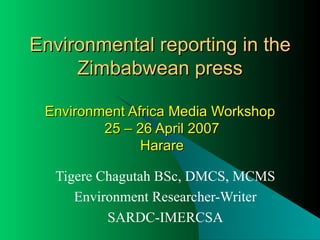Environmental reporting in the Zimbabwean press
- 1. Environmental reporting in the Zimbabwean press Environment Africa Media Workshop 25 ŌĆō 26 April 2007 Harare Tigere Chagutah BSc, DMCS, MCMS Environment Researcher-Writer SARDC-IMERCSA
- 2. This Session Background Patterns of coverage Story characteristics Hidden elements Why the current status?
- 3. Background
- 4. Defining the environment The simple and the technical Examples - Everything that surrounds anything - The complex set of physical, geographic, biological, social, cultural and political conditions that surround an individual or organism and that ultimately determines its form and nature of its survival - Chenje et al ŌĆ£ components of the earth, including air, land and water, all layers of the atmosphere, all organic and inorganic matter and living organisms, and the interacting systems that include all of these components.ŌĆØ
- 5. Categorising the environment News organisations employ rhetorical news classification (Beats) All encompassing nature of environment requires multidimensional analysis which is not possible in a 600 word story and in a straight jacket news beat Environment is thus reported in other news frames amenable to strict word limits and restrictions imposed by gatekeepers
- 6. The urban environment Growing urban settlements concentrated around areas of economic activity Industrial and domestic activity puts pressure on resources such as land/water Large volumes of chemical and biological waste Mushrooming of slum populations and unplanned urban agriculture Operation Murambatsvina
- 7. The rural environment Skewed land tenure has led to high population densities, overgrazing and general over exploitation in some areas and under utilisation in others Climate extremes exacerbated land degradation Land reform ŌĆō mismanagement has worsened the problem in some areas
- 8. Putting the environment on the media agenda ŌĆ£ Were the [African] media to be faced with the choice of covering either the natural or the political environment, they should, without any hesitation choose the latter, for in the African context, the mismanagement of the political sphere is the more imminent calamityŌĆØ ŌĆō Okigbo 1995 Role of advertisers, politics, sources, advocacy, etc
- 10. Issue/Beat coverage Absolute numbers (TSM above, TS below) show considerable coverage on environmental issues During this period political considerations play a significant role (consider Op M coverage) Crime news is dominant
- 11. Cycle of coverage Cyclic coverage (Issue attention Cycle - same observed for other news beats) Zero-sum game complementarity ŌĆō limited space on media agenda Clean up coverage sustained in TS below (political import)
- 12. Front Page stories Political stories dominant ŌĆō The commercial imperative Clean up stories show political leaning Environment least favoured as attention grabber
- 14. Use of pictures Both papers show high level of picture use ( about 50%) in environmental stories - illustrative Stand alone pictures often used for environmental stories and rarely in other beats ŌĆ£ a picture is worth more than a thousand words.ŌĆØ OR simplification??
- 15. Type of stories Hard news story dominates across beats Environmental news also dominantly hard news although there are features (not nearly enough as this is the most appropriate story type for environmental news) Lack of editorials shows editors preoccupation with other issues
- 17. Type of environment stories Hard news format shows a tendency towards covering trigger events, disasters and breaking news etc and less of slowly evolving issues and analyses which do well as features Lack of editorials in TSM (above) shows no concern with enviro issues at the highest level in newsroom
- 18. Themes in environment stories Uniformity Water and sanitation in major cities reflected 2007 energy crisis Climate and health related concerns during period of study reflected
- 19. Environment story headlines Significant number of non-specific headlines Attempt to frame story in favoured news frames
- 20. Hidden elements CDA used to unearth dominant news frames - Risk, Uncertainty, Fear, Crisis - Government sources used predominantly (officialdom brings credibility) - Less independent sources and advocacy groups and environment NGOs Pictures also used for framing eg Minister mugshot for credibility
- 21. Why the current status? (Concluding views from interviews) Environment news not commercially viable Lack of competence of reporters = lack of motivation ŌĆō few want to venture into env reporting therefore very few stories forwarded to news Eds Other beats command better readership and env is a ŌĆśspecial interest categoryŌĆÖ Lack of resources for going to the site of the story Lack of opportunity for training and no networks or fora for env reporters etc
- 22. Thank You! Tigere Chagutah [email_address] http://envirocom.wordpress.com







![Putting the environment on the media agenda ŌĆ£ Were the [African] media to be faced with the choice of covering either the natural or the political environment, they should, without any hesitation choose the latter, for in the African context, the mismanagement of the political sphere is the more imminent calamityŌĆØ ŌĆō Okigbo 1995 Role of advertisers, politics, sources, advocacy, etc](https://image.slidesharecdn.com/environmentalreportinginthezimbabweanpress-110112025424-phpapp02/85/Environmental-reporting-in-the-Zimbabwean-press-8-320.jpg)













![Thank You! Tigere Chagutah [email_address] http://envirocom.wordpress.com](https://image.slidesharecdn.com/environmentalreportinginthezimbabweanpress-110112025424-phpapp02/85/Environmental-reporting-in-the-Zimbabwean-press-22-320.jpg)